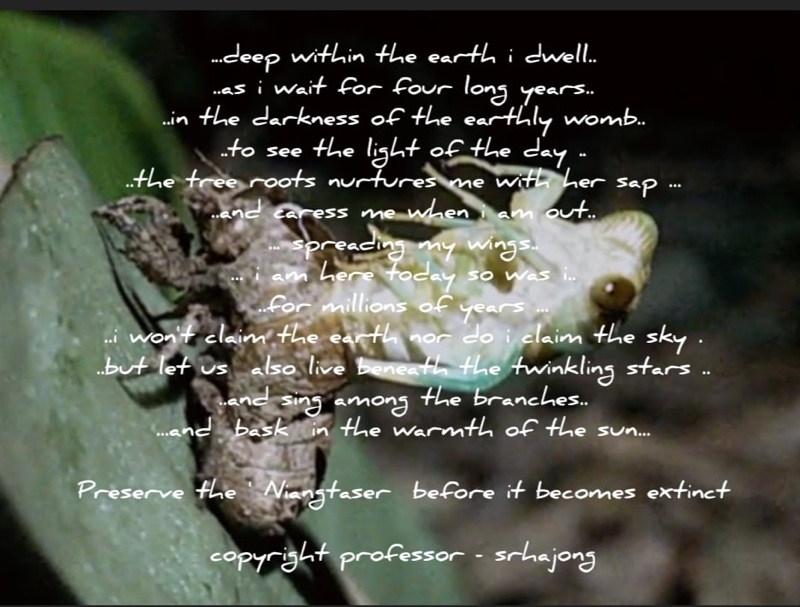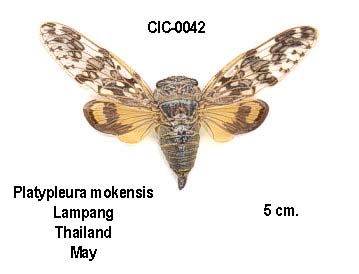Chremistica ribhoi, aka Niangtasar and the World Cup Cicada, is emerging! Chremistica ribhoi is a periodical cicada that lives in India (state of Meghalaya) and emerges every four years. It is nicknamed the World Cup cicada because it emerges the same year as the World Cup soccer/football sports event.
Sudhanya Ray Hajong sent us the following photos and text describing the event:
A molted, teneral (soft) male:

The worldcup cicada emergence May 2022
The four year long wait is over for the young and old of the villagers of Saiden village in the
northeastern Indian state of Meghalaya, and if you happen to be around you not fail to
notice the excitement among the young and old, men and women here in Saiden . It is
beginning of May and the World cup cicada or ‘Niangtaser’ as is called by the Bhoi
community has started emerging. The forest of Iewsier located on this a remote corner of
the world is suddenly buzzing with the calls of thousands of ‘Niangtaser’ or Chremistica
ribhoi Hajong & Yaakop, 2013.
Come sunset, one will see young children, boys and girls, and even aged man and
women with a bag carried around their shoulder, a piece of bamboo cane hung by tread
around their neck and a torch in hand – they are conversing in excitement and flocking in
small groups proceeding on trails taking them inside the forest. The atmosphere is almost
festive and everyone is so friendly and smiling expecting eagerly to seek out and pick as
many ‘ Niangtaser’ as possible, to be brought back home for delicious preparation and to
be pickles and dried and kept for months to relish the unique taste that Mother nature has
bestowed.
The nymphs with their powerful forelegs silently dig over ground in the stillness of the
night and one can see the still freshly emerged nymphs covered in soil crawling sluggishly
seeking anything upright to cling upward until they can secure themself on the surface with
their claws, the slow process then begins, with the splitting of the thoracic integument
along the mid dorsal line, the adult gradually pushes out of the shell until they are fully
outside the old exuviae, the wings which were crumpled slowly unfold and the now fully
emerged teneral adult with their fully spread-out wings appear as a beautiful greenish
ethereal glow under the soft light of our headlamps.
Come daylight and the adults now in hundreds and thousands fly out resting in clusters on
tips of twigs and branches of the several bamboos, one would hear the incessant and
almost whistling crescendo of calls of the ‘Niangtaser’ with the rising heat of the sun if you
are just below these trees one would feel the rain like shower drizzling earthward from the
hundreds of adults peeing from the tree tops.
This year though the fear of a fresh COVID resurgence had dampened the spirit of the
villagers of Siden , as no ‘Niangtaser’ Festival could be organised with much fanfare like
the previous emergence years.
The Folklore of the Bhoi people – A sick old women who was transformed into the
peeing ‘Niangtsers’
Long ago as the Bhoi Khasis of Siden village traditionally believed that, there lived an old
women who suddenly fell sick with a strange stomach ailment that made her to go
frequently to calls of nature for her frequent watery discharge. Fearing that her ailment
would spread among the villagers, the village elders finally decided that she was to taken
to the forest and kept separated alone in a bamboo thatch until she could get herself
cured. It is said that, when the villagers next morning went to check on her with food and
water, they were surprised to find they she had strangely vanished, but surprisingly they
found thousands of the cicadas everywhere on the branches of the trees and strangely all
of them were found to be discharging some kind of fluid from the rear of their abdomen.
They were thus lead to believe that the forest sprit feeling pity on her had transformed the
old sick women into thousands of the cicadas, and to this day the old women appear
around the forest of Iewsier in the form of thousands of ‘Niangtasers’ and even now she
still suffers from her stomach ailment and pass frequent watery discharges from the top of
trees.
Will the ‘Niangtaser’ come again and again, after every four years, few village the elders
who narrates how once upon a time ‘Niangtaser were plentiful and widespread; and how
now things have changed and how forest were gone along with many areas from were
‘Niangtaser’ are no more found. They are saddened by this development and tells us that
the number of ‘Niangtaser’is dwindling, forest patches where large number of them
emerges are no longer there, in its place farmlands and houses had appeared, they fear it
is not far when the folklore and the ‘Niangtaser’ that is so relished will vanish and only
remain a folklore of the distant past. The unique gift of mother nature may no longer be
there if we do not check our greed and our want for more and more land and more
material wealth. Village elders like Bah Kret Sungkli caution us that if we do not part our
greedy ways we may have to lose this wonderful gift of mother nature.
By Sudhanya Ray Hajong with able field assistance from my dear Rodeson Thangkiew,
who was inspired by ‘Niangtaser’ and to take up his PhD in cicadas.
A poem by Sudhanya Ray Hajong:

Two nymphs that have emerged from the ground:

A molting adult:

A molting adult:

A molting adult:

There’s also a brood of C. ribhoi that emerges during Leap-years.
Category: India
New species Becquartina bicolor and the genus Becquartina was discovered for the first time in India
News from Vivek Sarkar! A new cicada species, Becquartina bicolor, has been discovered in India.
This also marks the first time a cicada of the genus Becquartina was discovered in India.
Photos courtesy and copyright of Vivek Sarkar. Note the variation in colors.

From Vivek:
Here is a link to the paper by Vivek Sarkar, Rodeson Thangkhiew, Cuckoo Mahapatra, Pratyush P. Mohapatra, Manoj V. Nair, and Sudhanya R. Hajong: Discovery of the cicada genus Becquartina Kato, 1940 (Hemiptera: Cicadidae: Cicadinae) in India with the description of a new species from Meghalaya.
Photos courtesy and copyright of Vivek Sarkar.

Chremistica ribhoi, the World Cup Cicada, is emerging!
Chremistica ribhoi, aka Niangtasar and the World Cup Cicada, is emerging! Chremistica ribhoi is a periodical cicada that lives in India (state of Meghalaya) and emerges every four years. It is nicknamed the World Cup cicada because it emerges the same year as the World Cup soccer/football sports event.
Sudhanya Ray Hajong sent us the following photos and text describing the event:
A molted, teneral (soft) male:

A poem by Sudhanya Ray Hajong:

Two nymphs that have emerged from the ground:

A molting adult:

A molting adult:

A molting adult:

There’s also a brood of C. ribhoi that emerges during Leap-years.
Three new species of cicadas from Meghalaya, India
Three new species of cicadas have been discovered in Meghalaya, India:
Mata meghalayana, Mata lenonia, and Mata ruffordii.
Photo courtesy of Vivek Sarkar.
Access the paper on Research Gate or Zootaxa Vol 4908, No 1.
Paper title: Description of three new species of the genus Mata Distant, 1906 (Hemiptera: Cicadidae: Cicadinae: Oncotympanini) with notes on their natural history from the Indian state of Meghalaya, India
Authors: Vivek Sarkar, Cuckoo Mahapatra, Pratyush P. Mohapatra, Manoj V. Nair, Krushnamegh Kunte
Abstract: “Three new species of the Asian genus Mata Distant, 1906 (Hemiptera: Cicadidae) viz. Mata lenonia sp.nov.; Mata ruffordii sp.nov. and Mata meghalayana sp.nov. are described from the Indian state of Meghalaya. Keys and taxonomic descriptions of these species are provided with detailed accounts of their natural history and acoustics.”
Vittagaeana dives (Westwood, 1842)
This is a Vittagaeana dives (Westwood, 1842) from the W.T. Davis cicada collection at the Staten Island Museum. I believe they can be found in India.
This cicada was formerly known as Tosena dives, but its name recently changed due to research done as part of the article: Hill Kathy B. R., Marshall David C., Marathe Kiran, Moulds Maxwell S., Lee Young June, Pham Thai-Hong, Mohagan Alma B., Sarkar Vivek, Price Benjamin W., Duffels J. P., Schouten Marieke A., de Boer Arnold J., Kunte Krushnamegh, Simon Chris (2021) The molecular systematics and diversification of a taxonomically unstable group of Asian cicada tribes related to Cicadini Latreille, 1802 (Hemiptera:Cicadidae). Invertebrate Systematics 35, 570-601.
Scientific classification:
Family: Cicadidae
Subfamily: Cicadinae
Tribe: Gaeanini
Genus: Vittagaeana
Species: Vittagaeana dives (Westwood, 1842)
See the related cicada: Vittagaeana paviei (Noualhier, 1896)
Platypleura watsoni = Platypleura mokensis
Platypleura watsoni, also known as Platypleura mokensis, is a cicada found in Thailand, India, and Myanmar (Burma), and very likely adjacent nations.
Photo by Michel Chantraine:
]
Scientific classification:
Family: Cicadidae
Subfamily: Cicadinae
Tribe: Platypleurini
Genus: Platypleura
Species: Platypleura watsoni (Distant, 1897)
References:
Platypleura hampsoni (Distant, 1887)
Platypleura hampsoni is a cicada found in India.
Image and Description from A Monograph of Oriental Cicadas by W. L. Distant. 1889-1892. Read it on the Biodiversity Heritage Library website:
Scientific classification:
Family: Cicadidae
Subfamily: Cicadinae
Tribe: Platypleurini
Genus: Platypleura
Species: Platypleura hampsoni (Distant, 1887)
For more information about this cicada, visit Cicadas of India.
Platylomia radah (Distant, 1881)
Platylomia radah is a cicada found in Burma, China, India, Nepal, and Thailand.
Photo by Michel Chantraine:

Scientific classification:
Family: Cicadidae
Subfamily: Cicadinae
Tribe: Dundubiini
SubTribe: Dundubiina
Genus: Platylomia
Species: Platylomia radah (Distant, 1881)
For more information about this cicada, visit Cicadas of India.
Pomponia linearis (Walker, 1850)
Pomponia linearis is a cicada found in India.
Photo by Raghu Ananth taken in Bhagamandala, Coorg, India:
Scientific classification:
Family: Cicadidae
Subfamily: Cicadinae
Tribe: Cicadini
SubTribe: Psithyristriina
Genus: Pomponia
Species: Pomponia linearis (Walker, 1850)
For more information about this cicada, visit Cicadas of India.
Yasumasa Saisho of the Cicadae in Japan website left a note on Facebook about this cicada:
I’m putting this at the end. It is a description of Pomponia fusca which back in the 1800s was a “synonym” of Pomponia linearis, from A Monograph of Oriental Cicadas by W. L. Distant. 1889-1892. Read it on the Biodiversity Heritage Library website:
Platypleura capitata (Olivier, 1790)
Platypleura capitata is a cicada found in Sri Lanka and India.
Photos by Raghu Ananth, taken near Mysore, India:

Scientific classification:
Family: Cicadidae
Subfamily: Cicadinae
Tribe: Platypleurini
Genus: Platypleura
Species: Platypleura capitata (Olivier, 1790)
For more information about this cicada, visit Cicadas of India.
Macrosemia umbrata (Distant, 1888)
Macrosemia umbrata is a cicada found in China, Burma, India, Nepal, Thailand, and likely adjacent nations.
Photo by Raghu Ananth taken in Arunachal Pradesh, India.
This cicada is also known as Macrosemia chantrainei2. Here is a photo by Michel Chantraine:

Same insect?
Description (from when the cicada was known as Cosmopsaltria umbrata):
Scientific classification:
Family: Cicadidae
Subfamily: Cicadinae
Tribe: Dundubiini
SubTribe: Macrosemiina
Genus: Macrosemia
Species: Macrosemia umbrata (Distant, 1888)
For more information about this cicada, visit Cicadas of India.
References: